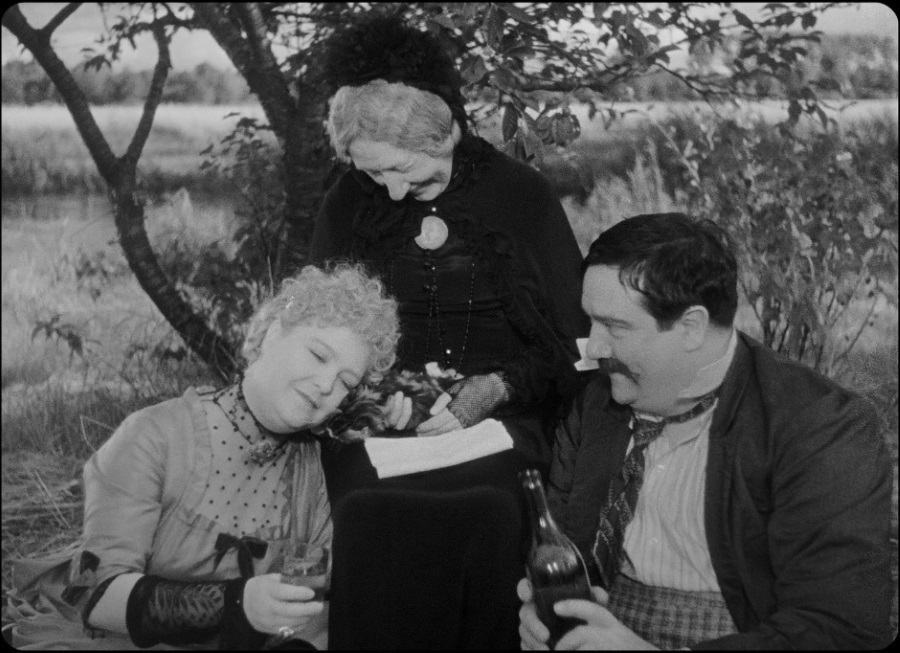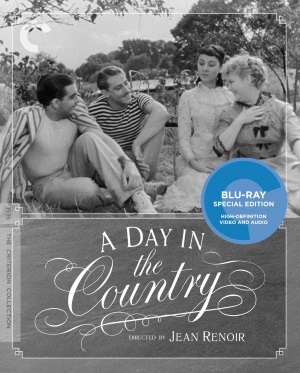 A Day in the Country (Criterion, Blu-ray, DVD) – Jean Renoir has long been called the cinematic successor to the French Impressionists—he is, after all, the son of Auguste Renoir, and his generosity and humanism and interest in the lives of working class folks is in the spirit of the movement. But while his style helped define French poetic realism of the 1930s, his films were also rooted in politics, class, and social commentary, both satirical (Boudu Saved from Drowning) and tragic (The Lower Depths, The Rules of the Game).
A Day in the Country (Criterion, Blu-ray, DVD) – Jean Renoir has long been called the cinematic successor to the French Impressionists—he is, after all, the son of Auguste Renoir, and his generosity and humanism and interest in the lives of working class folks is in the spirit of the movement. But while his style helped define French poetic realism of the 1930s, his films were also rooted in politics, class, and social commentary, both satirical (Boudu Saved from Drowning) and tragic (The Lower Depths, The Rules of the Game).
With A Day in the Country (1936), however, a short film adapted from a short story by Guy du Maupassant (a contemporary of his father), Renoir pays tribute to the French Impressionists in general and his father in particular. It’s set in 1860 at a bucolic riverside country inn on the Seine where a petit-bourgeois Paris family arrives (in a borrowed milk cart) for an escape from the city and a pair of brash men set their sights on seducing the giggly wife and the svelte, comely daughter of the easily-distracted husband.
It’s a bucolic little film with a wisp of a story that builds great emotional resonance from what appears to be a slight, meaningless dalliance. Like the Impressionists, there is great deal of life suggested behind those initial sketches, at least for some of the characters. Shots of this group having a picnic on the grass, women on swings, and couples rowing skiffs up the river, among others, evoke specific paintings of Pere Renoir while Jean’s gentle direction of his two leading actors create characters that are both familiar cultural types and unique individuals who are moved beyond all expectations by their brief encounter. It’s a portrait in the spirit of the paintings. Sylvia Bataille is especially luminous as the daughter, who is expected to marry her father’s dull-witted assistant but finds more excitement with the amorous country gentleman. Renoir himself plays the innkeeper and his lover and editor Marguerite Houlle Renoir is the waitress.
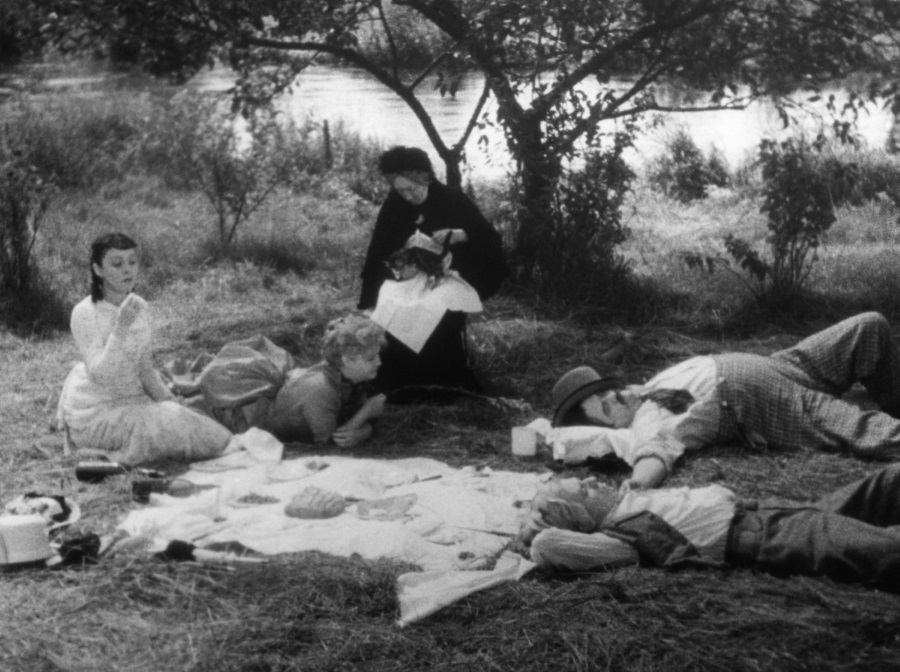
Renoir was unable to finish the film because of production delays caused by weather (it was an unseasonably rainy spring) and a prior commitment to feature film he was obligated to begin shooting, but the principle photography was mostly complete and a few additional location scenes were shot by assistant Jacques Becker (future cinema legend Luchino Visconti and photographer Henri-Cartier Bresson were also assistants on the production). The film was finally assembled a decade later by Marguerite Houlle Renoir (though they never married, she took his name) and Marinette Cadix, while Renoir was in the United States, with a couple of explanatory notes to cover city scenes that were never shot. In the simplicity of this film, they seem unnecessary.
The disc is gorgeous, mastered in 2k from a composite fine-grain 35mm print, with excellent detail and depth of image. The image is clean and vivid, which is remarkable for film of such vintage and difficult production history. Details of the production history are explained by Renoir historian Christopher Faulkner in the informative 24-minute interview featurette “The Road to A Day in the Country,” which was conducted for this disc. Also original to this disc is the video essay “Renoir at Work” by Faulkner.
In 1994, on the centenary of Renoir’s birth, outtakes from the production were assembled into an 89-minute showcase Un tournage a la campagne, which is most interesting for the insight to Renoir’s shooting methods. That rarity is also included in this set, along with an archival interview with producer Pierre Braunberger from 1979 and an introduction to the film that Renoir shot for French TV in 1962.
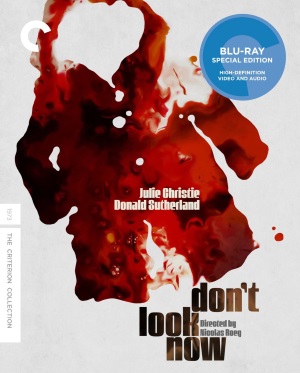 Don’t Look Now (Criterion, Blu-ray, DVD), Nicolas Roeg’s mosaic of a thriller, remains a mystery to the end. Set largely in Venice, where the labyrinth of canals and tunnels creates a claustrophobic maze, it’s less about the elliptical story (adapted from Daphne du Maurier’s short tale) than the texture of loss, obsession, and emotional remove. Donald Sutherland and Julie Christie are a married couple who lose their only child, a young daughter, to a drowning accident in a pond on their British estate. John (Sutherland) has a vision of her death, suggested in a blood-red spill across an art slide he’s studying, and that splash of red (the girl was wearing a red raincoat when she died) haunts his consciousness (and the film) like a ghost. Laura, meanwhile, meets a medium in Venice (where John is working to restore church artworks decaying from 20th century pollution) who convinces her that their daughter is still alive.
Don’t Look Now (Criterion, Blu-ray, DVD), Nicolas Roeg’s mosaic of a thriller, remains a mystery to the end. Set largely in Venice, where the labyrinth of canals and tunnels creates a claustrophobic maze, it’s less about the elliptical story (adapted from Daphne du Maurier’s short tale) than the texture of loss, obsession, and emotional remove. Donald Sutherland and Julie Christie are a married couple who lose their only child, a young daughter, to a drowning accident in a pond on their British estate. John (Sutherland) has a vision of her death, suggested in a blood-red spill across an art slide he’s studying, and that splash of red (the girl was wearing a red raincoat when she died) haunts his consciousness (and the film) like a ghost. Laura, meanwhile, meets a medium in Venice (where John is working to restore church artworks decaying from 20th century pollution) who convinces her that their daughter is still alive.
Most directors who begin as cinematographers favor long takes and camerawork as expressive tools. Roeg is more interested in the collision of images and builds his meanings and moods from connections and suggestions through often dense, impressionistic editing. In his hands, montage is more mosaic than metaphor, puzzle pieces that we put together in ways that create connections from association. Roeg plays with those connections to suggestion meanings beyond logic, but what we believe is insight to the supernatural may in fact be more expressive of John’s state of mind, making sense of loss by seeing echoes in the shadows of Venice.
The imagery is beautiful, to be sure, but also eerie and alienating and discomforting. Shooting in Venice gives Roeg the opportunity to use both the ageless beauty of the old-world churches and piazzas and canals and the mystery suggested in the maze of alleys and bridges and a street plan that can look like an Escher painting the way characters can be so close yet separated by the maze. And the performances by Christie and Sutherland both suggest a deep affection and an emotional distance. The deep scars of loss haunt their every action, even while making love.
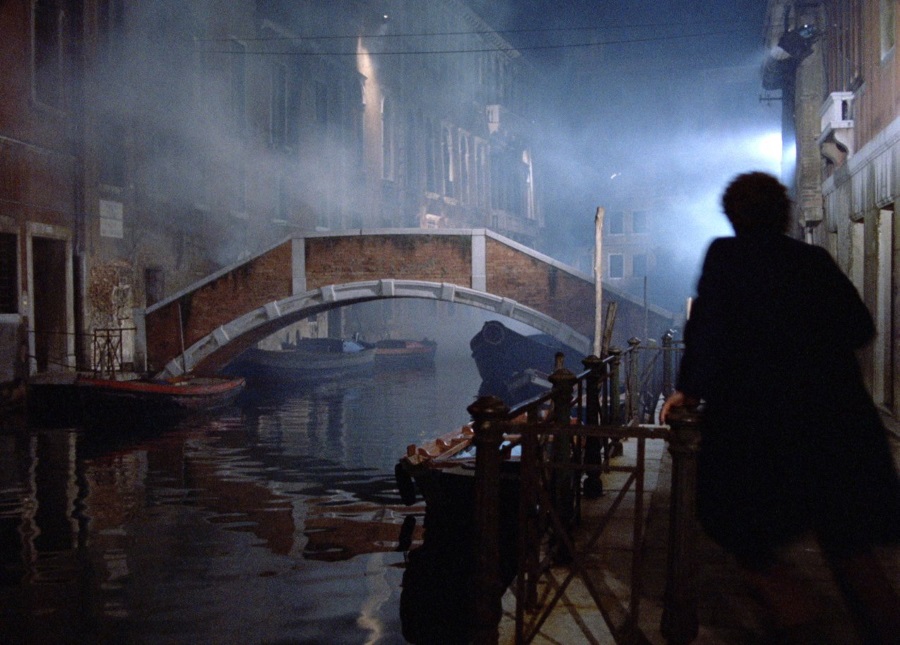
Nicolas Roeg approved this new digital restoration, mastered in 4K from the original camera negative. Roeg uses a cold color scheme which, while colorful, doesn’t have the richness or warmth we are used to in contemporary films, but this edition is true to his vision.
The new 30-minute documentary “Something Interesting” charts the origins, development, and production of the film through recent interviews with actors Julie Christie and Donald Sutherland, co-screenwriter Allan Scott, and cinematographer Anthony Richmond, and the 19-minute “Don’t Look Now, Looking Back,” featuring Nicolas Roeg, editor, Graeme Clifford, and cinematographer Anthony Richmond, is a companion piece created in 2002 for a previous disc release. Both are filled with telling production stories and interesting insights to the film. Filmmakers Danny Boyle and Steven Soderbergh pay tribute to Roeg in the 15-minute interview featurette “Nicolas Roeg: The Enigma of Film” (Soderbergh cites a key scene from Don’t Look Now as the inspiration for the love scene in Out of Sight).
Also features new interviews with editor Graeme Clifford and film writer Bobbie O’Steen and a 2006 interview with composer Pino Donaggio, plus a 47-minute Q&A with Roeg from a 2003 screening of the film. The accompanying insert is a fold-out poster with an essay by film critic David Thompson on the reverse side.
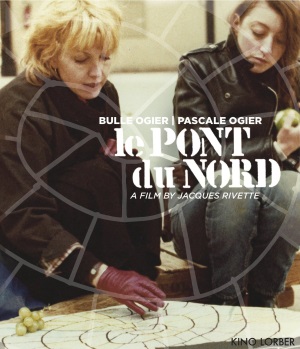 Making its stateside home video debut on Tuesday, February 17, is Jacques Rivette’s Le Pont du Nord (Kino Lorber, Blu-ray, DVD), a dark sister film to his more buoyant and whimsical Celine and Julie Go Boating. Longtime collaborator Bulle Ogier stars with her daughter, Pascale Ogier, and they co-write the film with Rivette and Suzanne Schiffman, which gives the characters and their journeys a decidedly female perspective, a hallmark of many of Rivette’s films. It also channels his love of puzzles, games, fantasy, and conspiracy with a story that tosses the two women together in Paris and sends them on an odyssey through the city, following clues and hopping through neighborhoods like they are squares in a massive boardgame with fatal stakes.
Making its stateside home video debut on Tuesday, February 17, is Jacques Rivette’s Le Pont du Nord (Kino Lorber, Blu-ray, DVD), a dark sister film to his more buoyant and whimsical Celine and Julie Go Boating. Longtime collaborator Bulle Ogier stars with her daughter, Pascale Ogier, and they co-write the film with Rivette and Suzanne Schiffman, which gives the characters and their journeys a decidedly female perspective, a hallmark of many of Rivette’s films. It also channels his love of puzzles, games, fantasy, and conspiracy with a story that tosses the two women together in Paris and sends them on an odyssey through the city, following clues and hopping through neighborhoods like they are squares in a massive boardgame with fatal stakes.
Marie (Bulle Ogier) arrives in the back of a pick-up truck—she’s spent the last few years in prison—with the intention of tracking down her old lover. Baptiste (Pascale Ogier) rides in on a moped, challenging a motorcycle rider like a kid playing matador and stepping off to slash the eyes from posters and placards. Marie is older, experienced, practical, disillusioned yet still hopeful, and she’s afflicted by a crippling claustrophobia that prevents her from even stepping inside stores. Baptiste is young, dreamy, a believer in fate and magic, and possibly unstable (her reflexive defacing of public imagery seems more compulsion than artistic statement). She’s also unfailingly loyal. When Baptiste sees that Marie’s criminal boyfriend Julien (Pierre Clémenti) is involved in shady business dealings, she appoints herself Marie’s guardian and takes the lead in investigating the contents of Julien’s briefcase, which includes newspaper clippings of political assassinations and of Marie’s criminal past. What’s the connection?
That’s for you to decide. Rivette doesn’t connect the dots so much as he follows the path of the game board, jumping from one square to another to make sense of the clues. The women discover that there are deadly stakes to this game but Rivette mixes fantasy with the fatalities and whimsy with the seriousness. Marie’s past connects her with the revolutionary spirit of the late-1960s that no longer exists by 1981, where the rich and powerful play games with lives. Baptiste’s idealism is less political than personal, perhaps a kind of chivalry. Her moped as much steed as machine and in the final act she takes on an amusement park slide in the design of a fire-breathing dragon like she’s a 20th century Don Quixote with tai chi moves. When a rival player attacks her, he puts her to sleep like a fairy tale princess, going so far to use a piece of stage craft to cocoon her in a literal web. Marie’s story is less whimsical, as her devotion to her criminal lover drags her into a criminal plot to which she remains willingly blind. Not that Baptiste understands it any better, but her drive to attack the eyes of the posters and artworks in the city echo with fears of surveillance. Who exactly is watching them?
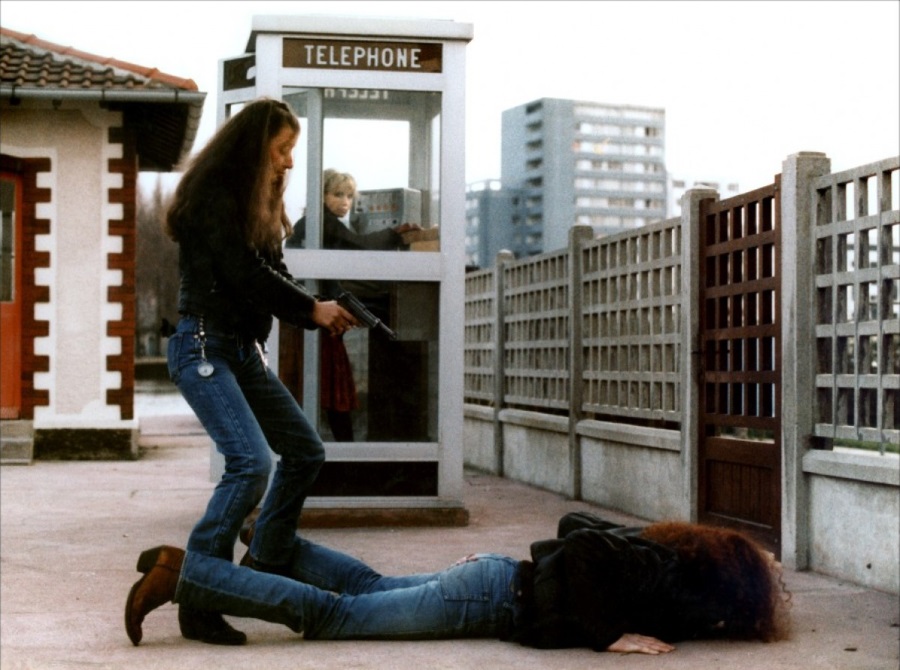
Le Pont du Nord is shot on location on the streets and in empty lots of Paris where buildings in various staged of demolition and construction suggest the skeleton behind the city. The scenes were worked out with the performers and then partially improvised and have a playful, meandering quality held together by Rivette’s dashes of humor and visual punning and the bond created between the two women. But this is a dark bookend to the cycle of films he began with his 1971 epic Out 1 and continued with Celine and Julie Go Boating (1974) and Duelle (1976).
Features the 13-minute video essay “Composites,” an experimental rumination on the film that I found uninformative, and the more useful but fairly inert 11-minute “Mapping Le Pont du Nord,” an image essay that goes through the film chronologically and identifies the locations of each scene.
Calendar of upcoming releases on Blu-ray, DVD, Digital, and VOD

